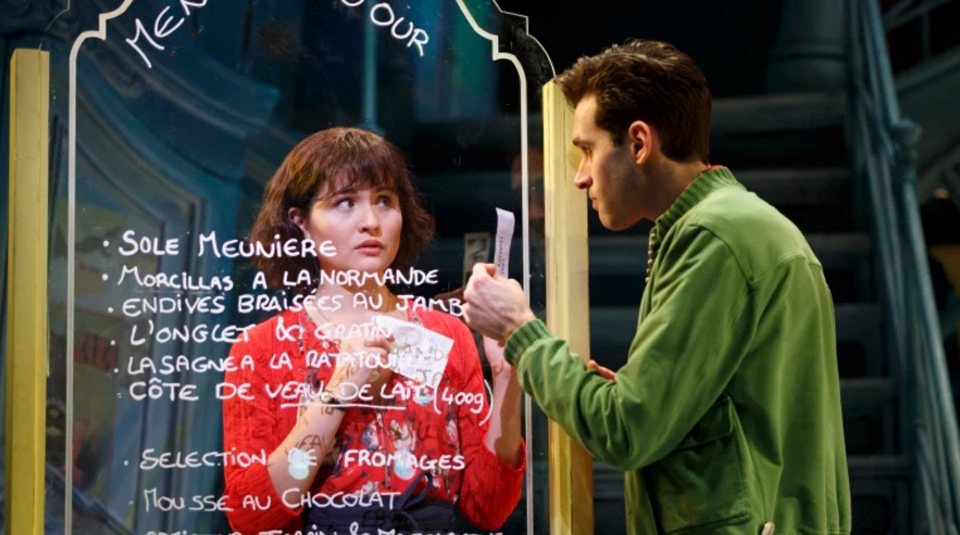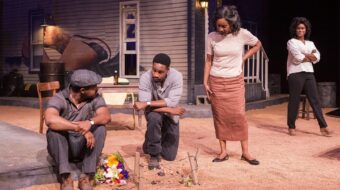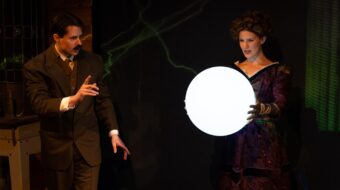
LOS ANGELES — L.A. theatergoers have been experiencing an embarrassment of onstage riches during the holiday season. The Dorothy Chandler Pavilion kicked things off with a rollicking rendition of Leonard Bernstein’s Wonderful Town, while Stephen Sondheim’s Merrily We Roll Along happily rolled at The Wallis Annenberg Center for the Performing Arts. Now, arguably the best of these lighthearted, good fun extravaganzas is delighting audiences at L.A.’s theatrical flagship, the Ahmanson.
Amélie, A New Musical is a stage version of the 2001 French film Amélie by Jean-Pierre Jeunet, starring the pre-Da Vinci Code, charm-your-knickers-off, très mignon Audrey Tautou. The cross-referencing of “content” from one medium to another frequently is a way to maximize brand recognition with a previously known quantity translated from film to the proscenium arch, the page to the cinema, the big screen to the little screen, live action to animation, and so on, back and forth, ad nauseam. Sequels also usually fall into this misbegotten “we’re only in it for the money” category.
A high percentage of Broadway shows are revivals and/or derived from other sources. The commercial motive comes at the expense of originality, which not only deprives viewers but harms artists. Case in point: Did the 2003 mediocre movie School of Rock really merit an Andrew Lloyd Webber makeover on the not-so-Great White Way, especially minus the rambunctious wit and presence of Jack Black?
Having got that off my chest, I went to see Amélie, A New Musical with some trepidation. How would they be able to convert this beloved, highly cinematic French film into an English-language musical for the legit stage? Could Tautou’s winsome performance be replicated?
Good news! I’m pleased to report that the theatrical version of Amélie is a non-stop delight, a visual and aural moveable feast with state-of-the-art stagecraft that is simply a joy to behold. Amélie is a young Parisian waitress (portrayed as an adult by Eurasian actress Phillipa Soo, Tony-nominated for Hamilton) who had an unusual childhood (Savvy Crawford plays Young Amélie), homeschooled by her mother Amandine (Alison Cimmet, who like others has a dual role, also playing Philomene, a flighty flight attendant) and largely raised by her overprotective father Raphael (Manoel Felciano, Tony-nominated for Sweeney Todd). Amélie grows up to become an inveterate do-gooder dedicated to making the lives of other people — including utter strangers — better. But in the process will she find her own happiness — and true love?
This is the basic plot of a play that’s about two hours long, performed sans intermission. Along the way Amélie encounters a cast of kooky, colorful characters at her café, apartment, the Métro, the boulevard, and so on. This being Paris, where La Bohème, the Impressionists, New Wave filmmakers, etc., were based, a number of them are artistes, including the photographer Nino (Adam Chanler-Berat), the writer Hipolito (Randy Blair), and the Renoir-obsessed dauber Dufayel (Tony Sheldon, who also appeared in another Broadway knock-off, Priscilla Queen of the Desert, for which he was Tony-nominated).
Amélie’s daffy demimonde also includes the café’s owner, former circus performer Suzanne (Harriett D. Foy, who previously acted in the ultra-derivative Mamma Mia! which went from Abba’s disco songs to the stage to the screen), and the jilted Gina (Maria-Christina Olveras of Broadway’s Bloody Bloody Andrew Jackson), etc.
The music, composed by Daniel Messé, who also co-wrote the lyrics with Nathan Tysen, is pleasant and pleasingly delivered. In a dual role, the oversized Randy Blair’s scene-stealing spoof of Sir Elton John is perhaps the funniest number in the show, which is well-acted and sung throughout.
But what makes Amélie such a special romp are the cockamamie surreal sets by Tony Award winner David Zinn (who also designed the creative costumes) that sometimes reminded me of the German Expressionist silent film The Cabinet of Dr. Caligari, but above all the truly spectacular special effects, conjured up by a team of theatrical alchemists that includes projection designer Peter Nigrini and co-lighting designers Jane Cox and Mark Barton. The onstage wizardry and magical mise-en-scène are all admirably overseen by Pam MacKinnon, a Tony-nominated director whose Broadway credits include productions by Edward Albee, David Mamet and Wendy Wasserstein.
This is such a heady, clever concoction that the show arguably raises the level of stagecraft to new 21st-century heights. Yet one of the best scenes is relatively simple and gives the expression “the revolving door” a whole new meaning: Will Amélie open up and let love enter her life?
Phillipa Soo may not surpass Audrey Tautou but she makes the role her own. The adult Amélie’s interactions with her younger self (Savvy Crawford) are psychologically astute and insightful and like much of this preternaturally beatific production extremely cinematic — as the attributes of moving pictures are brought to the realm of the live stage. What an imaginative amalgam of alchemy and optical opulence to rock your world!
I just have one “cautionary” note for potential ticket buyers: You should only attend Amélie, A New Musical if you relish romance, laughter, bedazzlement and highly entertaining theatre. A truly splendid time is guaranteed to all — and in these fraught times, there’s a lot to be said for that. So give yourself and your loved ones a great holiday gift: Tickets to the astoundingly amazing Amélie. What a lovely, philosophical treat playwright Craig Lucas and company have wrought for your viewing and listening pleasure.
Amélie, A New Musical is playing through Jan. 15, 2017 at the Ahmanson Theatre, 135 N. Grand Ave., Los Angeles, CA 90012. For more info: www.centertheatregroup.org/ or (213) 628-2772.












Comments